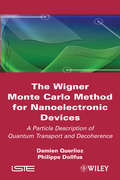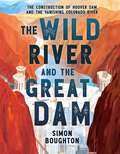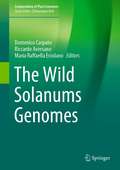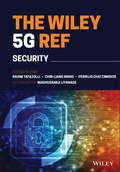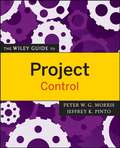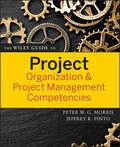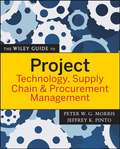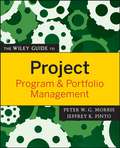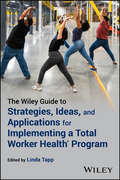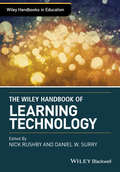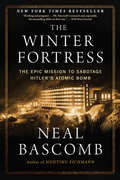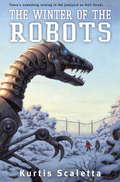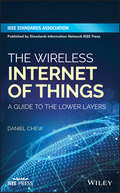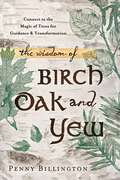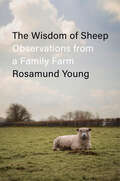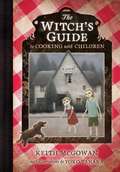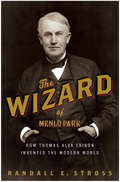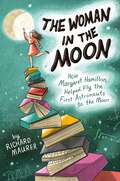- Table View
- List View
The Wigner Monte Carlo Method for Nanoelectronic Devices: A Particle Description of Quantum Transport and Decoherence (Wiley-iste Ser.)
by Damien Querlioz Philippe DollfusThis book gives an overview of the quantum transport approaches for nanodevices and focuses on the Wigner formalism. It details the implementation of a particle-based Monte Carlo solution of the Wigner transport equation and how the technique is applied to typical devices exhibiting quantum phenomena, such as the resonant tunnelling diode, the ultra-short silicon MOSFET and the carbon nanotube transistor. In the final part, decoherence theory is used to explain the emergence of the semi-classical transport in nanodevices.
The Wild River and the Great Dam: The Construction of Hoover Dam and the Vanishing Colorado River
by Simon BoughtonDiscover the complicated history behind the construction of Hoover Dam—one of the country’s most recognizable and far-reaching landmarks—and its lasting political and environmental effects on the Colorado River and the American West. <P><P> At the time of its completion in 1936, Hoover Dam was the biggest dam in the world and the largest feat of architecture and engineering in the country—a statement of national ambition and technical achievement. It turned the wild Colorado River into a tame and securely managed water source, transforming millions of acres of desert into farmland while also providing water and power to the fast-growing population of the Southwest. The concrete monolith quickly became a symbol of American ingenuity; however, its history is laden with contradiction. It provided work for thousands, but it was a dangerous project that exploited desperate workers during the Depression. It helped secure the settlement and economies of the Southwest, but at the expense of Indigenous peoples and the environment; and it created a dependency on the Colorado River’s water, which is under threat from overuse and climate change. <P><P> Weaving together elements of engineering, geography, and political and socioeconomic history, and drawing heavily from unpublished oral histories taken from dam workers and their families, Simon Boughton’s thoughtful and compelling debut—featuring historical photographs throughout—follows the construction and impact of Hoover Dam, and how its promise of abundance ultimately created a river in crisis today.
The Wild Solanums Genomes (Compendium of Plant Genomes)
by Domenico Carputo Riccardo Aversano Maria Raffaella ErcolanoThis book gathers the latest information on the organization of genomes in wild Solanum species and emphasizes how this information is yielding direct outcomes in the fields of molecular breeding, as well as a better understanding of both the patterns and processes of evolution. Cultivated Solanums, such as potato, tomato, and pepper, possess a high number of wild relatives that are of great importance for practical breeding and evolutionary studies. Their germplasm is often characterized by allelic diversity, as well as genes that are lacking in the cultivated species. Wild Solanums have not been fully exploited by breeders. This is mainly due to the lack of information regarding their genetics and genomics. However, the genome of important cultivated Solanaceae such as potato, tomato, eggplant, and pepper has already been sequenced. On the heels of these recent developments, wild Solanum genomes are now becoming available, opening an exciting new era for both basic research and varietal development in the Solanaceae.
The Wiley 5G REF: Security
by Madhusanka Liyanage Periklis Chatzimisios Rahim Tafazolli Chin-Liang WangFrom the Section Editor’s Foreword by Dr. Madhusanka Liyanage, University College Dublin, Ireland. The Wiley 5G Ref: Security offers a stellar collection of articles selected from the online-only Work, The Wiley 5G Reference. It aims to provide a solid educational foundation for researchers and practitioners in the field of 5G Security and Privacy to expand their knowledge base by including the latest developments in these disciplines. The book introduces the security landscape of 5G, and significant security and privacy risks associated with the 5G networks. Then, the security solutions for different segments of the 5G network, i.e., radio network, edge network, access network, and core network, are discussed. Since 5G is developed based on network softwarization, security threats associated with key network softwarization technologies such as SDN, NFV, NS, and MEC are also presented in detail. Then, the security issues related to the new 5G and IoT services are delivered. Finally, a detailed discussion on the privacy of 5G networks is presented by considering Datafied Society. Written by leading experts in security and privacy for the telecommunication network, this book is intended to provide additional learning opportunities for a wide range of readers, from graduate-level students to seasoned engineering professionals. We are confident that this book and the entire collection of selected articles will continue Wiley’s tradition of excellence in technical publishing and provide a lasting and positive contribution to the teaching and practice of security and privacy of 5G and beyond networks.
The Wiley Guide to Project Control (The Wiley Guides to the Management of Projects #9)
by Peter Morris Jeffrey K. PintoTimely and accessible content on the traditional project management activities of control, risk, time and cost, and quality and value The Wiley Guides to the Management of Projects address critical, need-to-know information that will help professionals successfully manage projects in most businesses and help students learn the best practices of the industry. They contain not only well-known and widely used basic project management practices but also the newest and most cutting-edge concepts in the broader theory and practice of managing projects. This second book in the series explains the "traditional" project management activities of control, risk, time, cost, and quality. The expert contributors show that project control represents more than the simple evaluation of project performance. They detail the principles of project time and cost control and offer a detailed review of critical chain project management. In addition, they provide a framework for project performance measurement, show how to make risk management more effective, and tell how to improve quality management. Touching on all of the fundamental levers of project control, this book will prove to be a comprehensive "owner's manual" for project and team managers, project team members, engineers, business consultants, and all those involved in any aspect of project management. Complete your understanding of project management with these other books in The Wiley Guides to the Management of Projects series: * The Wiley Guide to Project Organization & Project Management Competencies * The Wiley Guide to Project Technology, Supply Chain & Procurement Management * The Wiley Guide to Project, Program & Portfolio Management
The Wiley Guide to Project Organization and Project Management Competencies (The Wiley Guides to the Management of Projects #8)
by Peter Morris Jeffrey K. PintoA guide to the human factors in project management: knowledge, learning, and maturity The Wiley Guides to the Management of Projects address critical, need-to-know information that will help professionals successfully manage projects in most businesses and help students learn the best practices of the industry. They contain not only well-known and widely used basic project management practices but also the newest and most cutting-edge concepts in the broader theory and practice of managing projects. This third volume in the series covers a range of organizational and people-based topics that are occupying the project management world today. The essence of project management represents a "people" challenge-the ability to appreciate and effectively employ the competencies of all those who are associated with the project development and delivery process. This book explains how you can more successfully manage a project from inception through delivery by learning how to handle critical issues around structure, teams, leadership, power and negotiation, and the whole area of competencies. The expert contributors also include chapters on global project management knowledge and standards, the role of project management associations around the world, project management maturity models, and other key topics. Complete your understanding of project management with these other books in The Wiley Guides to the Management of Projects series: * The Wiley Guide to Project Control * The Wiley Guide to Project, Program & Portfolio Management * The Wiley Guide to Project Technology, Supply Chain & Procurement Management
The Wiley Guide to Project Technology, Supply Chain, and Procurement Management (The Wiley Guides to the Management of Projects #7)
by Jeffrey K. Pinto Peter W. G. MorrisA complete guide to managing technical issues and procuring third-party resources The Wiley Guides to the Management of Projects address critical, need-to-know information that will help professionals successfully manage projects in most businesses and help students learn the best practices of the industry. They contain not only well-known and widely used basic project management practices but also the newest and most cutting-edge concepts in the broader theory and practice of managing projects. This fourth volume in the series offers expert guidance on the supply chain and delivery cycle of the project, as well as the technology management issues that are involved such as modeling, design, and verification. Technology within the context of the management of projects involves not so much actually doing the "technical" elements of the project as managing the processes and practices by which projects are transformed from concepts into actual entities-and doing this effectively within the time, cost, strategic, and other constraints on the project. The contributors to this volume, among the most recognized international leaders in the field, guide you through the key life-cycle issues that define the project, ensure its viability, manage requirements, and track changes-highlighting the key steps along the way in transforming and realizing the technical definition of the project. Complete your understanding of project management with these other books in The Wiley Guides to the Management of Projects series: * The Wiley Guide to Project Control * The Wiley Guide to Project, Program & Portfolio Management * The Wiley Guide to Project Organization & Project Management Competencies
The Wiley Guide to Project, Program, and Portfolio Management (The Wiley Guides to the Management of Projects #10)
by Peter Morris Jeffrey K. PintoA comprehensive guide to project management and its interaction with other management systems and strategies The Wiley Guides to the Management of Projects address critical, need-to-know information that will enable professionals to successfully manage projects in most businesses and help students learn the best practices of the industry. They contain not only well-known and widely used basic project management practices but also the newest and most cutting-edge concepts in the broader theory and practice of managing projects. This first book in the series, The Wiley Guide to Project, Program & Portfolio Management, is based on the "meta" level of management, which, simply stated, asserts that project management must be integrated throughout an organization in order to achieve its full potential to enhance the bottom line. This book will show you how to fully understand and exploit the strategic management of projects, portfolios, and program management and their linkage with context and strategy in other concepts and processes, such as quality management, concurrent engineering, just-in-time delivery, systems management and engineering, teams, and statistical quality control. Featuring contributions from experts all around the world, this invaluable resource book offers authoritative project management applications for industry, service businesses, and government agencies. Complete your understanding of project management with these other books in The Wiley Guides to the Management of Projects series: * The Wiley Guide to Project Control * The Wiley Guide to Project Organization & Project Management Competencies * The Wiley Guide to Project Technology, Supply Chain & Procurement Management
The Wiley Guide to Strategies, Ideas, and Applications for Implementing a Total Worker Health Program
by Linda TappAddresses safety and health hazards through a holistic, organization-wide approach to worker wellbeing The Wiley Guide to Strategies, Ideas, and Applications for Implementing a Total Worker Health® Program presents specific information and guidance for Total Worker Health (TWH) applications in a variety of industries as well as specific aspects of TWH. This book covers how existing safety and health activities can support and be integrated into TWH programs, exploring specific topics such as how TWH initiatives can benefit the construction industry, ways to borrow from successful safety committee operations, and the use of technology. The innovative ideas and techniques from diverse fields, and from existing safety and health programs, help readers maximize efforts and increase the chance of long-term success. Case studies are included throughout to elucidate key concepts and aid in reader comprehension. Written by safety, health, and wellness practitioners with real-world experience, this resource includes: Organizational approaches for implementing key prevention programs to solve problems across diverse worker populationsGuidance for improving the organization and design of work environments, including innovative strategies for promoting worker wellbeingEvidence of program effectiveness for addressing work conditions that impact mental health, fatigue and sleep, and work-life conflictPerspective of traditional safety and health professionals, emphasizing practical advice for practitioners throughout all chapters and connecting the narrative as a whole The Wiley Guide is an essential resource for safety, health, and industrial hygiene practitioners in industry, public services, government, insurance, and consulting, as well as others with safety and health responsibilities such as occupational medicine professionals.
The Wiley Handbook of Learning Technology (Wiley Handbooks in Education)
by Nick Rushby Daniel W. SurryThe Wiley Handbook of Learning Technology is an authoritative and up-to-date survey of the fast-growing field of learning technology, from its foundational theories and practices to its challenges, trends, and future developments. Offers an examination of learning technology that is equal parts theoretical and practical, covering both the technology of learning and the use of technology in learning Individual chapters tackle timely and controversial subjects, such as gaming and simulation, security, lifelong learning, distance education, learning across educational settings, and the research agenda Designed to serve as a point of entry for learning technology novices, a comprehensive reference for scholars and researchers, and a practical guide for education and training practitioners Includes 29 original and comprehensively referenced essays written by leading experts in instructional and educational technology from around the world
The Wind at Work: An Activity Guide to Windmills
by Gretchen WoelfleExplaining how the wind works, what windmills have contributed to the past, and why they offer environmental promise today as a source of clean, renewable energy, this revised and updated edition offers a glimpse into all the current and historical uses for wind power. Featuring new information on wind energy technology and wind farms, new photographs, and 24 wind-related activities--from keeping track of household energy use and conducting science experiments to cooking traditional meals and creating arts and crafts--this handy resource offers kids interested in the science of energy and green technologies an engaging, interactive, and contemporary overview of wind power.
The Winding Stair: Francis Bacon, His Rise and Fall
by Daphne Du Maurier"Unlike many authors of popular historical biographies, du Maurier resembled Antonia Fraser in being an indefatigable researcher." --Francis King Many accounts of the life of Francis Bacon have been written for scholars. But du Maurier's aim in this biography was to illuminate the many facets of Bacon's remarkable personality for the common reader. To her book she brought the same gifts of imagination and perception that made her earlier biography, Golden Lads, so immensely readable, skillfully threading into her narrative extracts from contemporary documents and from Bacon's own writings, and setting her account of his life within a vivid contemporary framework.
The Windows Screen Reader Primer: All the Basics and More
by David KingsburyFor those with visual impairments, screen reader software is crucial for living in today’s world. Keeping up to date with changes when applications are updated is critical to being an independent computer user. Authored by an Assistive Technology Instructor at the Carroll Center for the Blind in Massachusetts, the book is meant to help JAWS, NVDA, and Windows Narrator users work more effectively with the most important Windows-based applications—the Microsoft Office suite, popular web browsers, cloud sharing apps, Zoom for meetings, and more. The book is intended for both beginners and intermediate users. While all the basics are covered, those already possessing a fair amount of experience using screen reader programs in the Windows environment will find useful tools and techniques to further enhance their skills.
The Winter Fortress: The Epic Mission to Sabotage Hitler's Atomic Bomb
by Neal BascombFrom the internationally acclaimed, best-selling author of Hunting Eichmann and The Perfect Mile, an epic adventure and spy story about the greatest act of sabotage in all of World War II. It's 1942 and the Nazis are racing to be the first to build a weapon unlike any known before. They have the physicists, they have the uranium, and now all their plans depend on amassing a single ingredient: heavy water, which is produced in Norway's Vemork, the lone plant in all the world that makes this rare substance. Under threat of death, Vemork's engineers push production into overdrive. For the Allies, the plant must be destroyed. But how would they reach the castle fortress set on a precipitous gorge in one of the coldest, most inhospitable places on Earth? Based on a trove of top secret documents and never-before-seen diaries and letters of the saboteurs, The Winter Fortress is an arresting chronicle of a brilliant scientist, a band of spies on skies, perilous survival in the wild, sacrifice for one's country, Gestapo manhunts, soul-crushing setbacks, and a last-minute operation that would end any chance Hitler could obtain the atomic bomb--and alter the course of the war.
The Winter of the Robots
by Kurtis ScalettaSeven feet of snow, four science-fair nerds, one creepy junkyard. Get ready for the ultimate robot battle.Jim is tired of being the sidekick to his scientific genius, robot-obsessed, best friend Oliver. So this winter, when it comes time to choose partners for the science fair, Jim dumps Oliver and teams up with a girl instead. Rocky has spotted wild otters down by the river, and her idea is to study them. But what they discover is bigger--and much more menacing--than fuzzy otters: a hidden junkyard on abandoned Half Street. And as desolate as it may seem, there's something living in the junkyard. Something that won't be contained for long by the rusty fences and mounds of snow. Can Jim and Rocky--along with Oliver and his new science-fair partner--put aside their rivalry and unite their robot-building skills? Whatever is lurking on Half Street is about to meet its match.From the Hardcover edition.
The Wireless Internet of Things: A Guide to the Lower Layers
by Daniel ChewProvides a detailed analysis of the standards and technologies enabling applications for the wireless Internet of Things The Wireless Internet of Things: A Guide to the Lower Layers presents a practitioner’s perspective toward the Internet of Things (IoT) focusing on over-the-air interfaces used by applications such as home automation, sensor networks, smart grid, and healthcare. The author—a noted expert in the field—examines IoT as a protocol-stack detailing the physical layer of the wireless links, as both a radio and a modem, and the media access control (MAC) that enables communication in congested bands. Focusing on low-power wireless personal area networks (WPANs) the text outlines the physical and MAC layer standards used by ZigBee, Bluetooth LE, Z-Wave, and Thread. The text deconstructs these standards and provides background including relevant communication theory, modulation schemes, and access methods. The author includes a discussion on Wi-Fi and gateways, and explores their role in IoT. He introduces radio topologies used in software-defined radio implementations for the WPANs. The book also discusses channel modelling and link budget analysis for WPANs in IoT. This important text: Introduces IEEE 802.15.4, ITU-T G.9959, and Bluetooth LE as physical layer technology standards enabling wireless IoT Takes a layered approach in order to cultivate an appreciation for the various standards that enable interoperability Provides clarity on wireless standards with particular focus on actual implementation Written for IoT application and platform developers as well as digital signal processing, network, and wireless communication engineers; The Wireless Internet of Things: A Guide to the Lower Layersoffers an inclusive overview of the complex field of wireless IoT, exploring its beneficial applications that are proliferating in a variety of industries.
The Wireless Tesla
by Nikola TeslaNikola Tesla dreamed of a wireless future. In this volume we have collected thirteen of his essays having to do with wireless. These include the "True Wireless," "Tesla's Wireless Light," "The Transmission of Electrical Energy Without Wires," "The Future of the Wireless Art," "Nikola Tesla Sees A Wireless Vision," and many others. Nikola Tesla has been called the most important man of the 20th Century. Without Tesla's ground-breaking work we'd all be sitting in the dark without even a radio to listen to.
The Wisdom of Birch, Oak, and Yew: Connect to the Magic of Trees for Guidance & Transformation
by Penny BillingtonTune into the wisdom of three trees sacred to Druids—birch, oak, and yew—and use their powerful lessons and natural gifts to transform your life. Written by a Druid with more than twenty years of practical experience, The Wisdom of Birch, Oak, and Yew will guide you through a one-of-a-kind journey of magical self-discovery. Its unique invitation: change your perspective by "being as a tree" and consider yourself in light of the qualities of our arboreal friends.Engage with the spirit of each tree and explore its relationship to the stages of your life and the rhythm of your days. Experience within yourself each tree's positive attributes, gain perspective by taking on each tree's role as "witness," and find respite from the frenetic pace of modern life.Praise:"Wise, inspiring, and entertaining, this is a profoundly practical book about nature's magic and how it supports our personal development. I warmly recommend it."—Dr. William Bloom, author of The Power of Modern Spirituality"A very fine book on the deep magic of the trees. Penny Billington shows us how these trees function as guides and initiators, teachers and friends and along the way gives us a first rate introduction to working with the energies of the land to promote healing and new life."—Ian Rees, Psychotherapist, Trainer, and Program Director of the Annwn Foundation
The Wisdom of Sheep: Observations from a Family Farm
by Rosamund Young&“Elegiac, funny, warm and wise, The Wisdom of Sheep will delight country folk and city dwellers alike.&” —Katherine MayA touching, wise and surprising chronicle of the rich inner lives of animals, drawn from Rosamund Young&’s extraordinary lifetime as an organic farmerWe talk a lot about sheep: following the herd, counting sheep to fall asleep and looking out for wolves in sheep&’s clothing. But, just like people, animals don&’t always follow the pack. Some are affectionate while others butt heads; some follow the leader while some guide the whole flock home. With startling beauty and tenderness, Rosamund Young reveals the remarkable emotional and intellectual complexity of the animals she lives with on her family farm, and the story of her life&’s work, with the intimacy of a personal diary.Just as she did in her acclaimed book, The Secret Life of Cows, Young transports readers to the wild meadows of Kite&’s Nest Farm, where she has worked as an organic farmer for over forty years, at the beck and call of the abundant wildlife, living in direct contact with the consciousnesses of her beloved animals. Through tender portraits of her sometimes eventful but always rewarding days at Kite&’s Nest, Young recounts a multitude of discoveries, such as how cows converse with one another, why sheep are so strongheaded—and why you should never, ever text whilst milking. That&’s a lesson you need learn only once.This is a story of joy, discovery, cooperation and, sometimes, heartbreak. But through it all, The Wisdom of Sheep is a fresh and delightful tribute to the miraculous inner worlds of the animals all around us and what we can learn about them, and about ourselves, by watching them more closely.
The Witch's Guide to Cooking with Children
by Yoko Tanaka Keith McgowanEleven-year-old inventor Sol must recover his self-confidence if he and his eight-year-old sister, Connie, are to escape the clutches of Hansel and Gretel's witch, to whom they have been led by their new stepmother and the man they believe is their father.
The Wizard and the Prophet: Two Remarkable Scientists and Their Dueling Visions to Shape Tomorrow's World
by Charles C. MannFrom the best-selling, award-winning author of 1491 and 1493--an incisive portrait of the two little-known twentieth-century scientists, Norman Borlaug and William Vogt, whose diametrically opposed views shaped our ideas about the environment, laying the groundwork for how people in the twenty-first century will choose to live in tomorrow's world. In forty years, Earth's population will reach ten billion. Can our world support that? What kind of world will it be? Those answering these questions generally fall into two deeply divided groups--Wizards and Prophets, as Charles Mann calls them in this balanced, authoritative, nonpolemical new book. The Prophets, he explains, follow William Vogt, a founding environmentalist who believed that in using more than our planet has to give, our prosperity will lead us to ruin. Cut back! was his mantra. Otherwise everyone will lose! The Wizards are the heirs of Norman Borlaug, whose research, in effect, wrangled the world in service to our species to produce modern high-yield crops that then saved millions from starvation. Innovate! was Borlaug's cry. Only in that way can everyone win! Mann delves into these diverging viewpoints to assess the four great challenges humanity faces--food, water, energy, climate change--grounding each in historical context and weighing the options for the future. With our civilization on the line, the author's insightful analysis is an essential addition to the urgent conversation about how our children will fare on an increasingly crowded Earth.
The Wizard of Menlo Park
by Randall StrossAt the height of his fame Thomas Alva Edison was hailed as “the Napoleon of invention” and blazed in the public imagination as a virtual demigod. Newspapers proclaimed his genius in glowing personal profiles and quipped that “the doctor has been called” because the great man “has not invented anything since breakfast. ” Starting with the first public demonstrations of the phonograph in 1878 and extending through the development of incandescent light, a power generation and distribution system to sustain it, and the first motion picture cameras—all achievements more astonishing in their time than we can easily grasp today—Edison’s name became emblematic of all the wonder and promise of the emerging age of technological marvels. But as Randall Stross makes clear in this critical biography of the man who is arguably the most globally famous of all Americans, Thomas Edison’s greatest invention may have been his own celebrity. Edison was certainly a technical genius, but Stross excavates the man from layers of myth-making and separates his true achievements from his almost equally colossal failures. How much credit should Edison receive for the various inventions that have popularly been attributed to him—and how many of them resulted from both the inspiration and the perspiration of his rivals and even his own assistants? How much of Edison’s technical skill helped him overcome a lack of business acumen and feel for consumers’ wants and needs? This bold reassessment of Edison’s life and career answers these and many other important questions while telling the story of how he came upon his most famous inventions as a young man and spent the remainder of his long life trying to conjure similar success. We also meet his partners and competitors, presidents and entertainers, his close friend Henry Ford, the wives who competed with his work for his attention, and the children who tried to thrive in his shadow—all providing a fuller view of Edison’s life and times than has ever been offered before. The Wizard of Menlo Park reveals not only how Edison worked, but how he managed his own fame, becoming the first great celebrity of the modern age.
The Wizard of Menlo Park: How Thomas Alva Edison Invented the Modern World
by Randall E. StrossAt the height of his fame Thomas Alva Edison was hailed as "the Napoleon of invention" and blazed in the public imagination as a virtual demigod. Newspapers proclaimed his genius in glowing personal profiles and quipped that "the doctor has been called" because the great man "has not invented anything since breakfast." Starting with the first public demonstrations of the phonograph in 1878 and extending through the development of incandescent light, a power generation and distribution system to sustain it, and the first motion picture cameras--all achievements more astonishing in their time than we can easily grasp today--Edison's name became emblematic of all the wonder and promise of the emerging age of technological marvels.But as Randall Stross makes clear in this critical biography of the man who is arguably the most globally famous of all Americans, Thomas Edison's greatest invention may have been his own celebrity. Edison was certainly a technical genius, but Stross excavates the man from layers of myth-making and separates his true achievements from his almost equally colossal failures. How much credit should Edison receive for the various inventions that have popularly been attributed to him--and how many of them resulted from both the inspiration and the perspiration of his rivals and even his own assistants? How much of Edison's technical skill helped him overcome a lack of business acumen and feel for consumers' wants and needs?This bold reassessment of Edison's life and career answers these and many other important questions while telling the story of how he came upon his most famous inventions as a young man and spent the remainder of his long life trying to conjure similar success. We also meet his partners and competitors, presidents and entertainers, his close friend Henry Ford, the wives who competed with his work for his attention, and the children who tried to thrive in his shadow--all providing a fuller view of Edison's life and times than has ever been offered before. The Wizard of Menlo Park reveals not only how Edison worked, but how he managed his own fame, becoming the first great celebrity of the modern age.From the Hardcover edition.
The Wizard of Menlo Park: How Thomas Alva Edison Invented the Modern World
by Randall StrossA bold reassessment of Edison, telling the story of how he came upon his most famous inventions as a young man and spent the remainder of his long life trying for similar success.
The Woman in the Moon: How Margaret Hamilton Helped Fly the First Astronauts to the Moon
by Richard MaurerA stunning and intimate biography of Margaret Hamilton, the computer engineer who helped Apollo 11 and mankind get from the Earth to the moon.First-hand accounts, exclusive interviews with the legendary Margaret Hamilton, and detailed science populate the pages of this remarkable biography. In 1969, mankind successfully left our atmosphere and landed on the moon. It took countless hours of calculations, training, wonder, and sacrifice from all of the men and women who worked hard to make that landing. One of those people was Margaret Hamilton. A young computer engineer, Hamilton was hired to develop the completely new software used in the groundbreaking Apollo Space Program. Soon she became the lead engineer, one of the few women in the almost entirely male-dominated profession. But it wasn't always easy. In The Woman in the Moon, science-writer and journalist Richard Maurer (Destination Moon, 2019) dives deep into the backstory of this extraordinary woman. With first-hand interviews and access to primary sources, this striking biography perfectly captures the exciting atmosphere of the Space Race and the inspiring figure of Margaret Hamilton.
